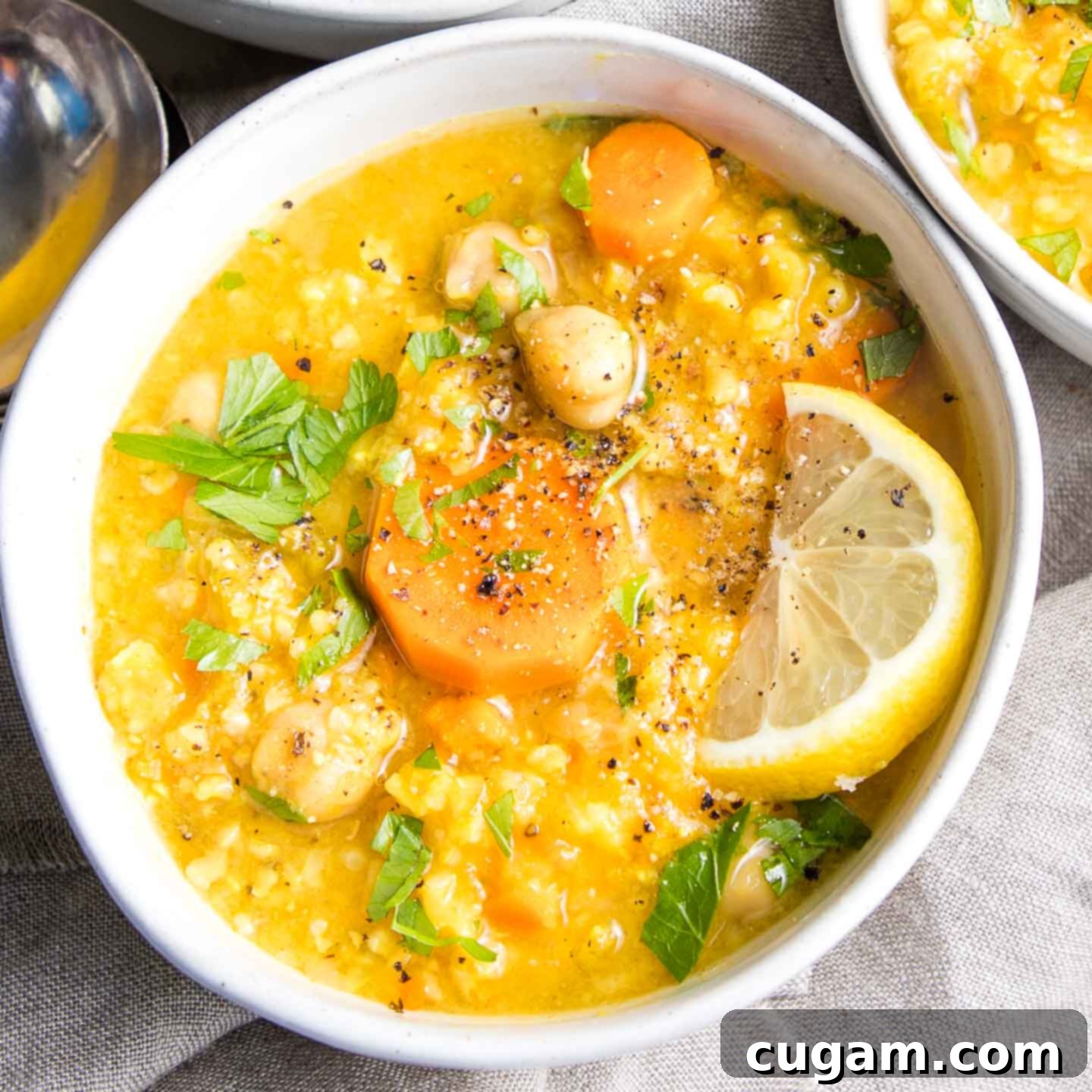Hearty & Nourishing: The Ultimate Vegan Lemon Chickpea Rice Soup (One-Pot Wonder!)
When the craving for something genuinely comforting, deeply nourishing, and incredibly satisfying hits, look no further than this delightful **Lemon Chickpea Rice Soup**. It’s more than just a meal; it’s a warm hug in a bowl, designed to nourish both body and soul. This easy-to-make, one-pot vegan recipe promises a wholesome experience without the fuss, making it perfect for any day of the week.
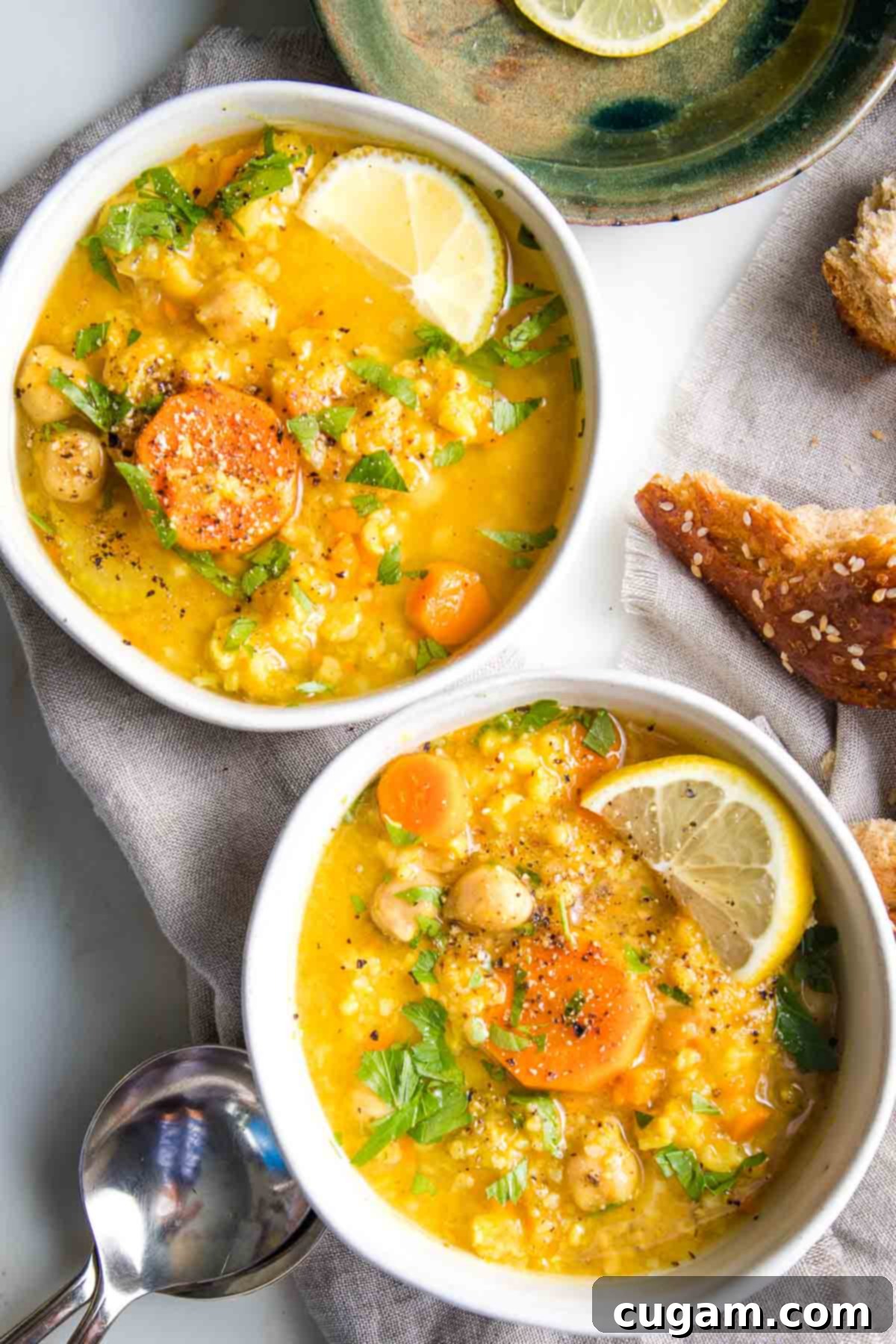
This recipe brings together simple, wholesome ingredients to create a symphony of flavors and textures. Imagine a soup that’s both hearty and surprisingly light, brimming with warming spices, vibrant colors, and an amazing chewy, nutty texture from the chickpeas and rice. It’s the kind of dish that truly satisfies, making it a staple for fall and winter, though it’s delicious all year round.
The beauty of this lemony chickpea soup lies in its simplicity. Being a true one-pot meal means minimal cleanup, and with very little hands-on time, you can effortlessly whip it up on an average weeknight. It’s proof that you don’t need complicated ingredients or techniques to create something truly spectacular and nutritious.
Why You’ll Fall in Love with This Vegan Chickpea Soup
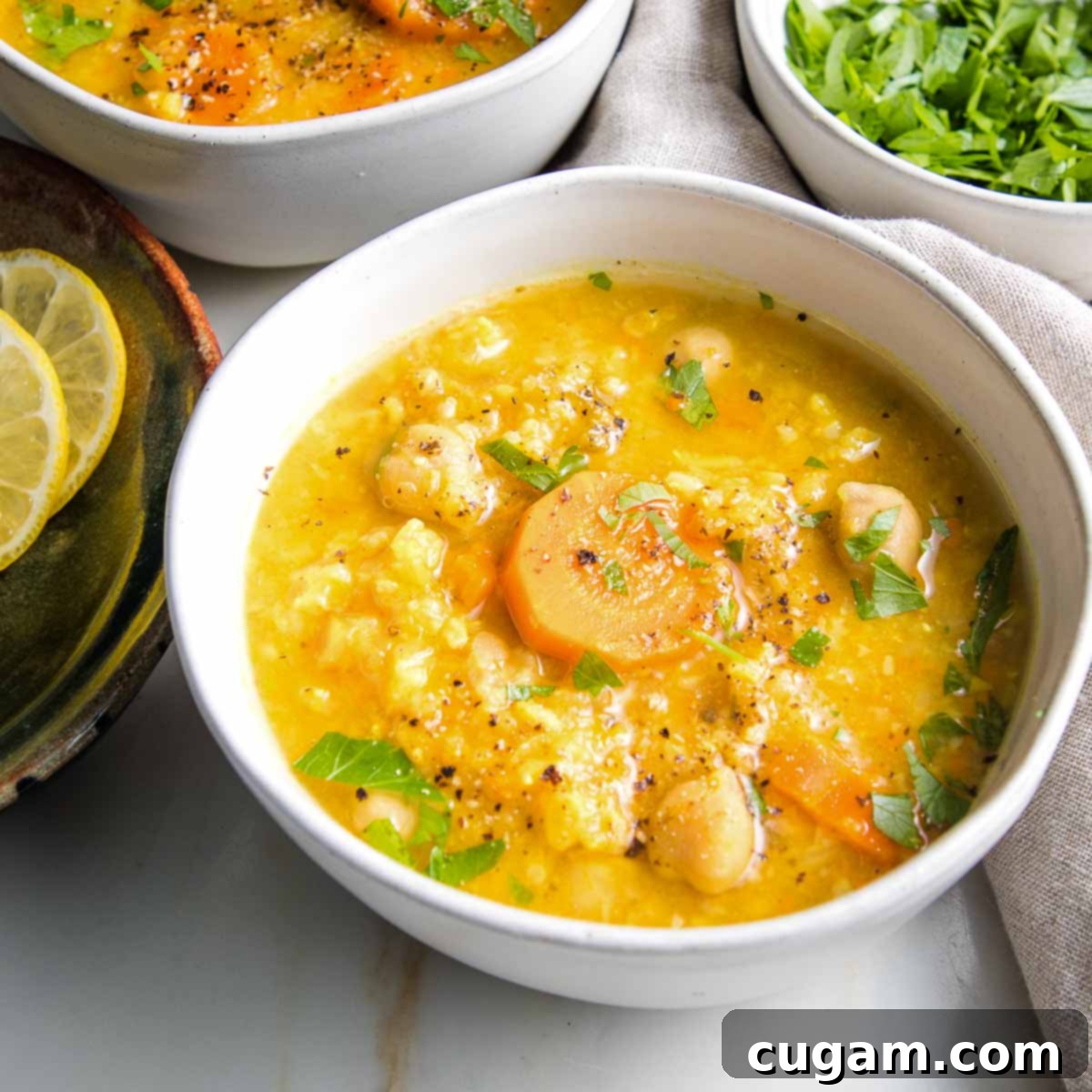
- Unforgettably Satisfying: This soup boasts an incredible texture and rich, layered flavors that make it deeply fulfilling without being heavy. The combination of chewy chickpeas, tender rice, and perfectly cooked vegetables creates a delightful mouthfeel that will keep you coming back for more.
- Effortless One-Pot Wonder: Our busy lives demand convenient meals, and this soup delivers! Cook everything in a single pot for dramatically reduced cleanup. Here’s a little secret: I often store the leftovers right in the cooking pot in the fridge, meaning virtually no immediate cleanup after dinner – a true win-win!
- Nutritious Powerhouse: Packed with plant-based protein from chickpeas, fiber from both chickpeas and vegetables, and a spectrum of antioxidants and anti-inflammatory ingredients like turmeric, this soup is a nutritional hero. It’s a wholesome meal that supports your well-being.
- Ideal for Healthy Meal Prep: Planning your meals just got easier! This chickpea and rice soup holds up beautifully throughout the week, with flavors that deepen over time. Cook a larger batch once and enjoy nutritious lunches or dinners for days. Plus, it freezes exceptionally well, making it perfect for future cravings.
- Versatile for Any Meal: Whether you’re looking for a comforting lunch, a satisfying dinner, or even a unique and energizing breakfast (yes, I often enjoy this soup to break my fast in the morning!), this recipe fits the bill. Its balanced profile makes it suitable for any time of day.
Key Ingredients and Smart Substitutions
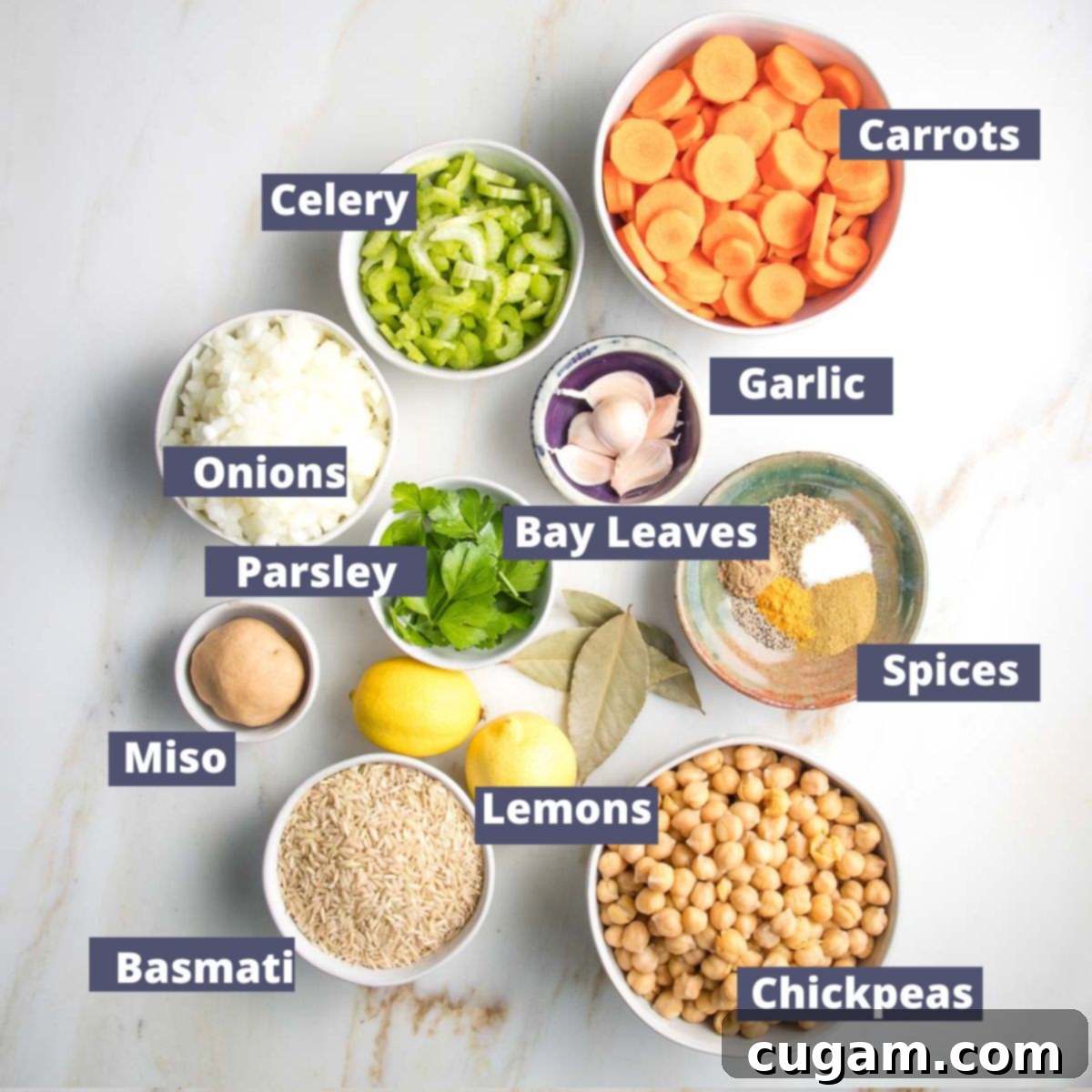
Crafting this flavorful lemon chickpea soup requires a handful of accessible ingredients. Here’s a closer look at what you’ll need and some clever substitutions to suit your pantry and preferences:
- Chickpeas: These legumes are the star, providing a significant boost of plant-based protein and fiber, making the soup incredibly hearty and satisfying. They contribute a wonderful texture and absorb the vibrant flavors beautifully. If you don’t have chickpeas, great northern beans make an excellent alternative.
- Basmati Rice: I recommend either brown or white basmati rice for its fragrant aroma and distinct texture. The combination of rice and beans creates a complete plant-based protein, offering all essential amino acids. Jasmine rice is another fantastic substitution if basmati isn’t available.
- Mirepoix (Onions, Carrots, Celery): This classic aromatic base is the “soup beginning” for a reason! Sautéing these vegetables creates a foundational layer of savory sweetness that is essential for a truly flavorful soup. Don’t skip this step – it sets the stage for deliciousness.
- Lemons: Absolutely crucial for that signature bright, zesty flavor! Lemon juice and zest are added at the end to provide a burst of freshness that elevates all the other ingredients. The acidity also helps to balance the richness of the soup.
- Miso Paste: A true secret weapon for vegan cooking! Miso is a fermented soybean paste (though chickpea miso is a great soy-free option) that delivers a profound umami flavor, adding depth and complexity that can often be missing in plant-based dishes. It acts as a superb flavor enhancer, much like it does in my split pea soup. I typically use mellow light miso, which offers a delicate, savory touch without overpowering the other flavors.
- Garlic: Fresh garlic, grated directly into the pot, infuses the soup with its pungent, aromatic goodness, complementing the mirepoix and spices perfectly.
- Spices (Oregano, Cumin, Coriander, Turmeric): This blend of spices is what gives the soup its warming, comforting character. Oregano adds a herbaceous note, cumin and coriander contribute earthy warmth, and turmeric not only gives the soup a beautiful golden hue but also offers powerful anti-inflammatory benefits.
- Vegetable Broth: The liquid base for our soup. Using a high-quality vegetable broth will significantly impact the overall flavor. If you use homemade vegetable stock, you might need to adjust the salt content.
- Bay Leaves: These humble leaves impart a subtle, savory, and slightly peppery undertone that deepens the soup’s flavor profile during cooking. Remember to remove them before serving!
- Fresh Parsley: A vibrant garnish that adds a pop of color and a fresh, herbaceous finish.
Choosing the Best Rice for Your Lemon Chickpea Soup
The type of rice you choose can influence the soup’s texture and overall character. I often use **brown basmati rice** for its nutty flavor and slightly chewy texture, which adds a wonderful dimension to the soup. However, I’ve also had fantastic results with **white jasmine rice**, which cooks faster and provides a softer, more delicate texture.
For an intriguing twist, you could even try **wild rice**. While technically a grass, not a true rice, it offers a distinctly chewy texture and an earthy flavor. Keep in mind that wild rice takes about 10-15 minutes longer to cook than white rice, and you’ll know it’s done when the grains “pop” open. It’s a great choice if you’re looking for a grain-free alternative.
Ultimately, the “best” rice is truly the one you already have in your pantry! Feel free to experiment with what you enjoy and what’s easily accessible to you. Just remember that cooking times may vary slightly, so always taste-test to ensure it’s cooked to your preferred chewiness.
How to Create This Delightful Soup: A Step-by-Step Guide
Making this hearty lemon chickpea rice soup is a straightforward and enjoyable process. Follow these steps to create a truly delicious and comforting meal:
Begin by heating a Dutch oven or a large, heavy-bottomed soup pot over medium heat. This is where our flavor journey begins. Instead of oil, we’ll perform a quick “water sauté” with your chopped onions, carrots, and celery (the mirepoix). I’ve found no discernible difference in the final taste when using water instead of olive oil, making this a lighter and healthier option. Add a couple of tablespoons of water or vegetable broth to the hot pan, and add your vegetables. Sauté, stirring occasionally, for about 5 minutes, adding more water a tablespoon at a time if the pan becomes too dry, until the vegetables begin to soften and lightly brown.
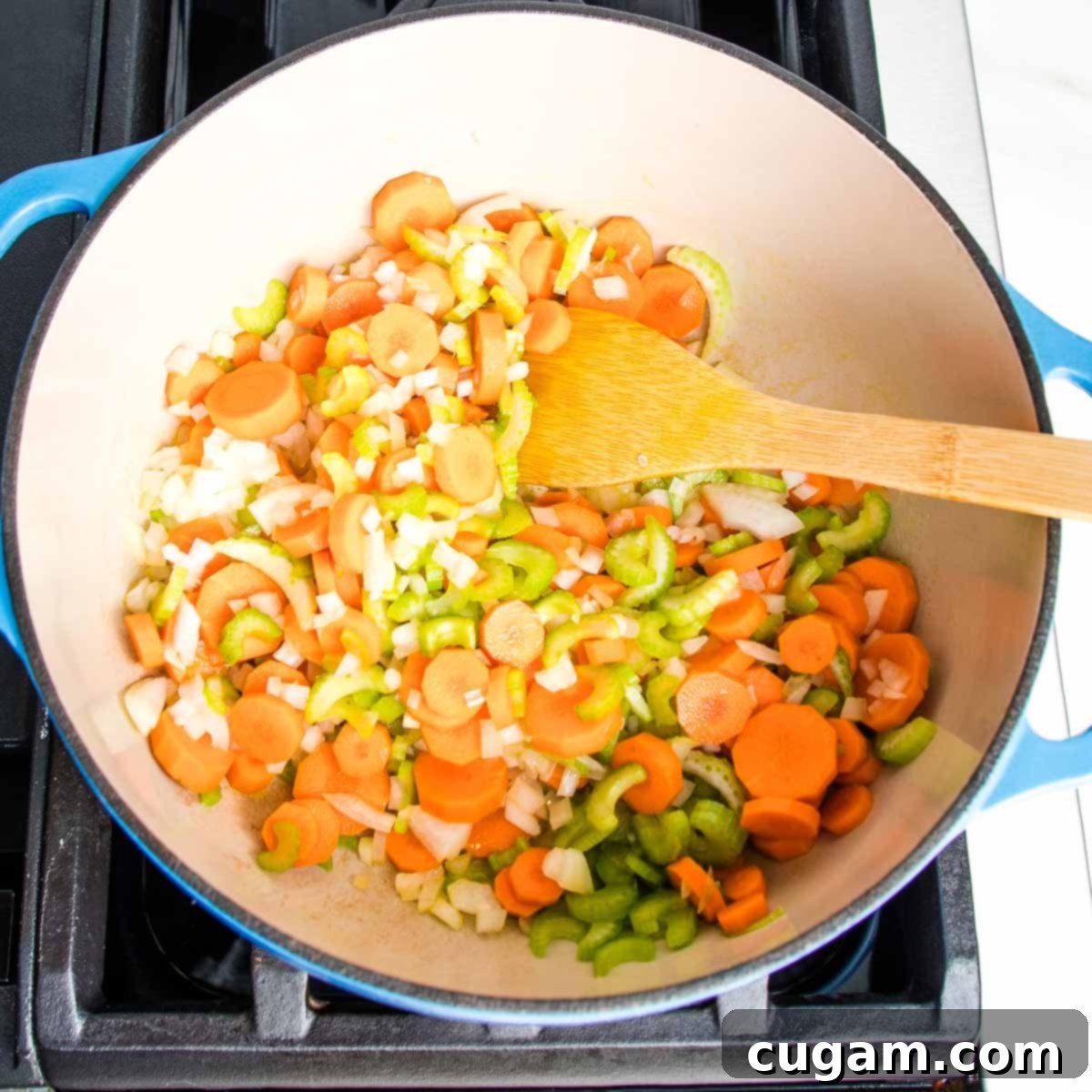
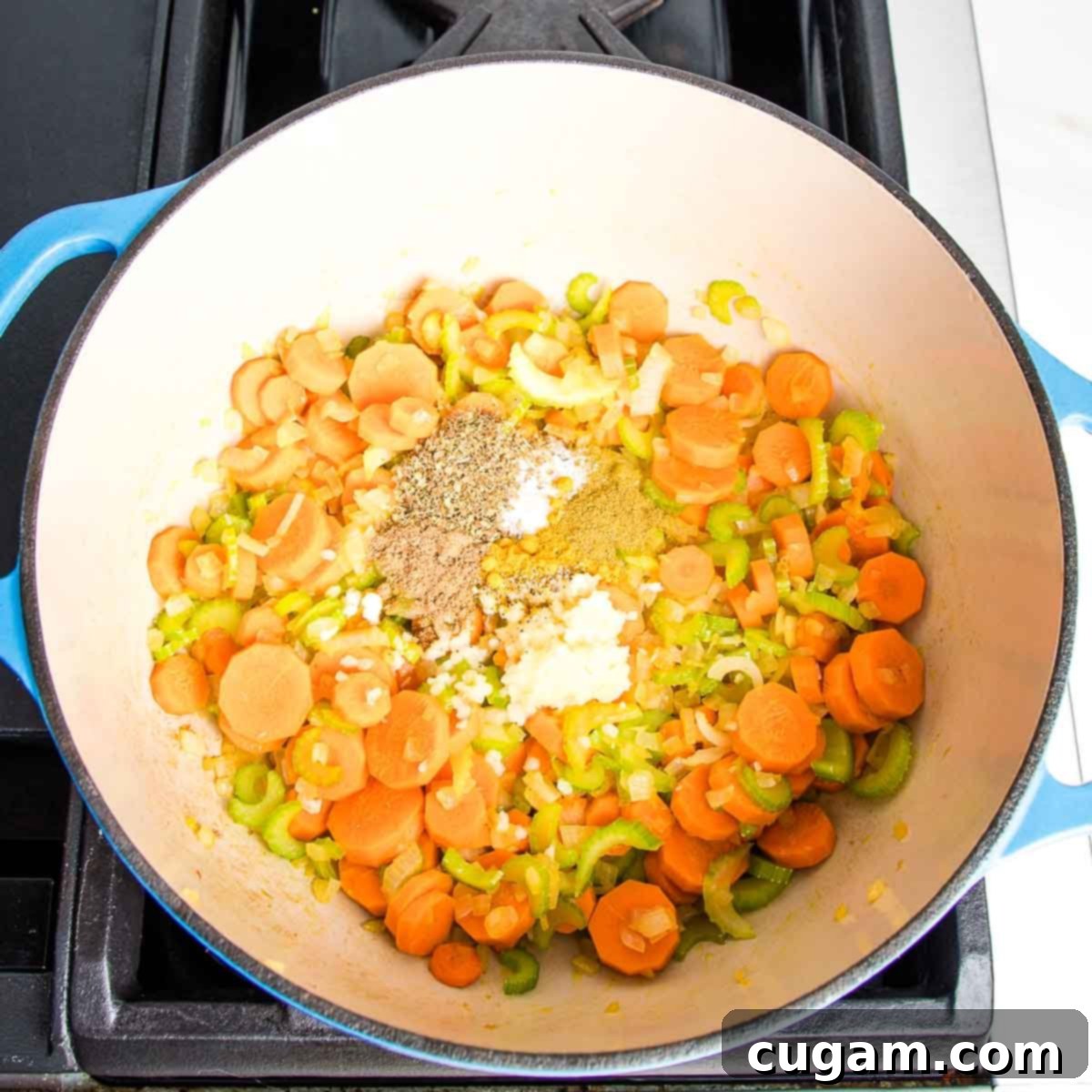
Next, it’s time to infuse the soup with incredible aroma and flavor. Add in your measured spices: dried oregano, ground cumin, ground coriander, and ground turmeric. Freshly grate the garlic directly into the pot using a microplane zester for the best texture and distribution. As these spices hit the heat, you’ll immediately smell the fragrant combination of cumin, garlic, onions, oregano, and coriander — it’s truly intoxicating and tells you something delicious is on its way. Stir constantly for about 2 minutes, allowing the spices to bloom and release their full flavor, adding a splash more water or broth if necessary to prevent sticking.
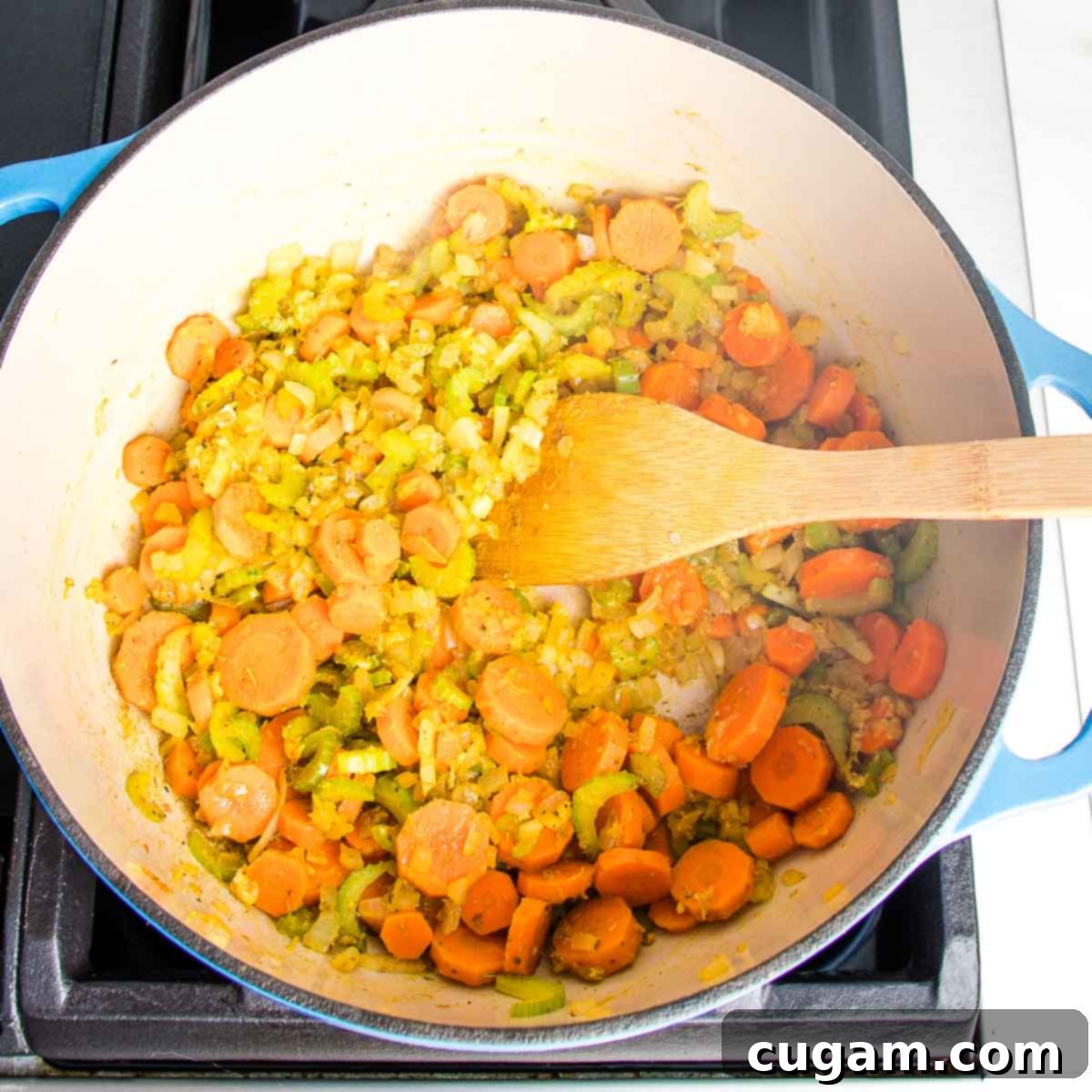
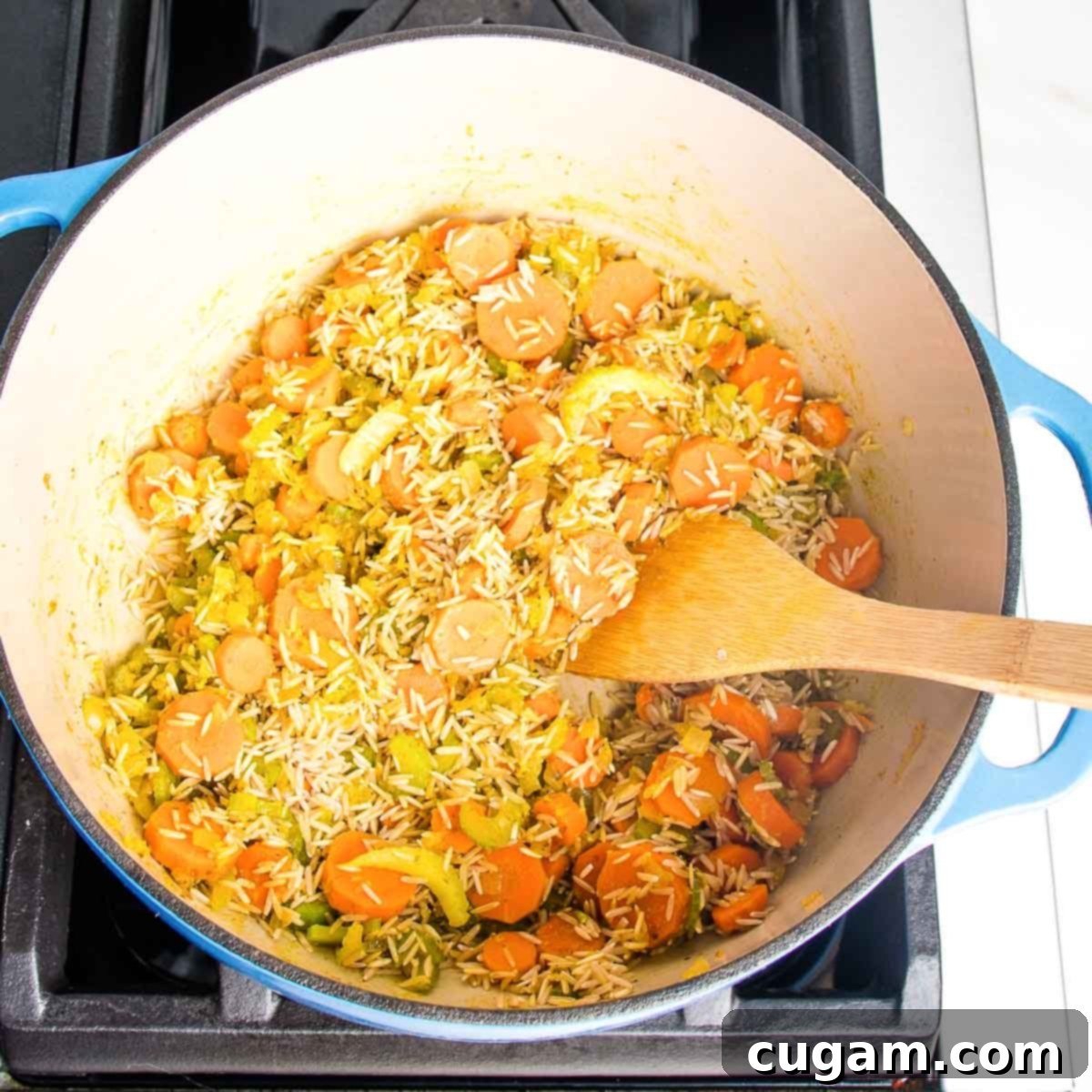
Now, add the rinsed basmati rice to the pot and stir it thoroughly, ensuring each grain is beautifully coated with the fragrant spice mixture. This brief “toasting” helps to enhance the rice’s flavor. Continue to add 1-2 tablespoons of water or vegetable broth as needed to keep the pan from becoming too dry and prevent sticking.
Pour in the generous eight cups of vegetable broth and add the bay leaves. Bring the mixture to a gentle simmer, then let it cook uncovered for about 20 minutes. During this time, the rice will begin to absorb the liquid and cook. Next, stir in the chickpeas and the light miso paste. Make sure the miso is fully incorporated – you can even dissolve it in a few tablespoons of the warm soup broth in a separate small bowl first to make this process easier before adding it to the main pot. Continue to simmer for another 10-15 minutes, or until the rice is perfectly chewy but not mushy. Once the rice is cooked to your liking, remove and discard the bay leaves.
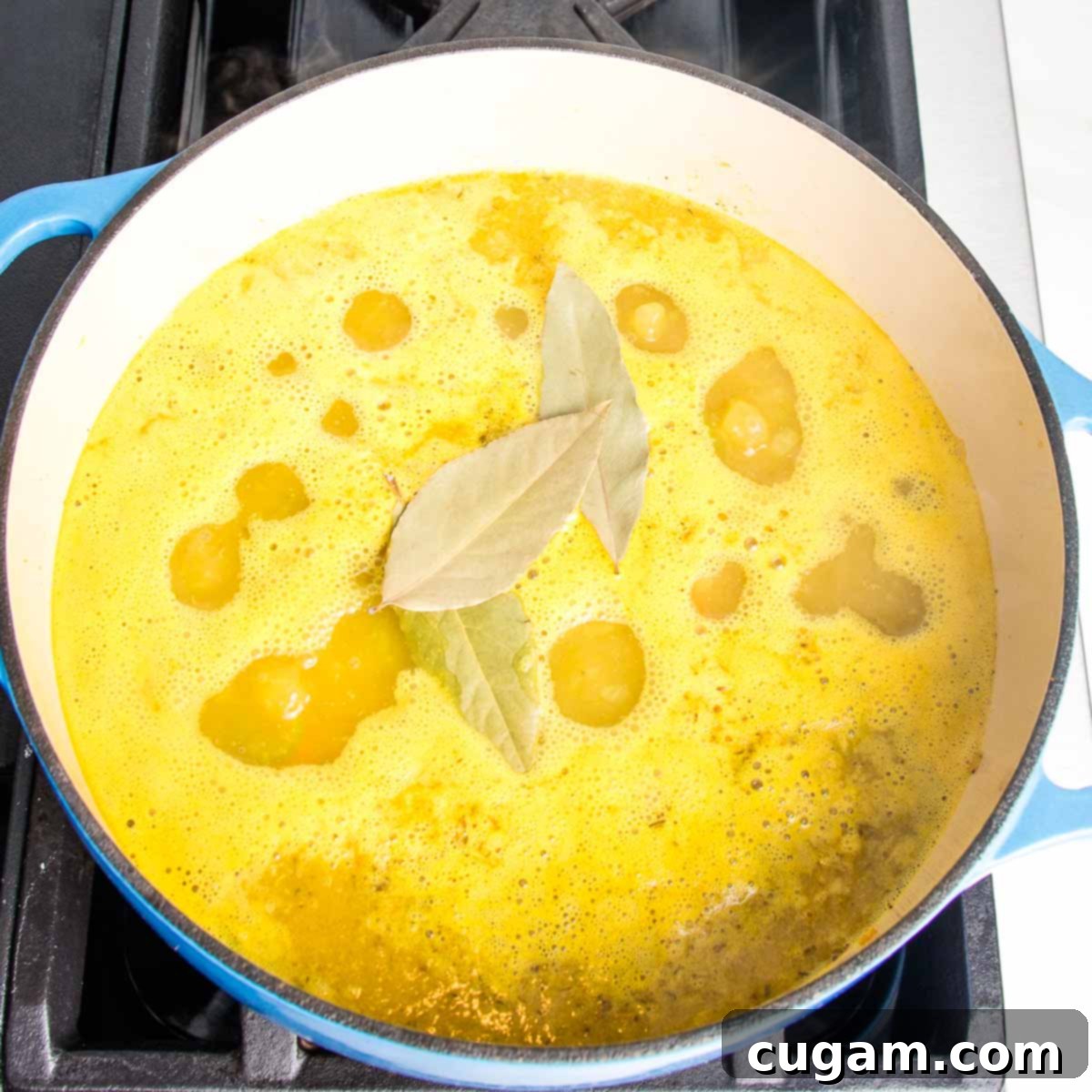
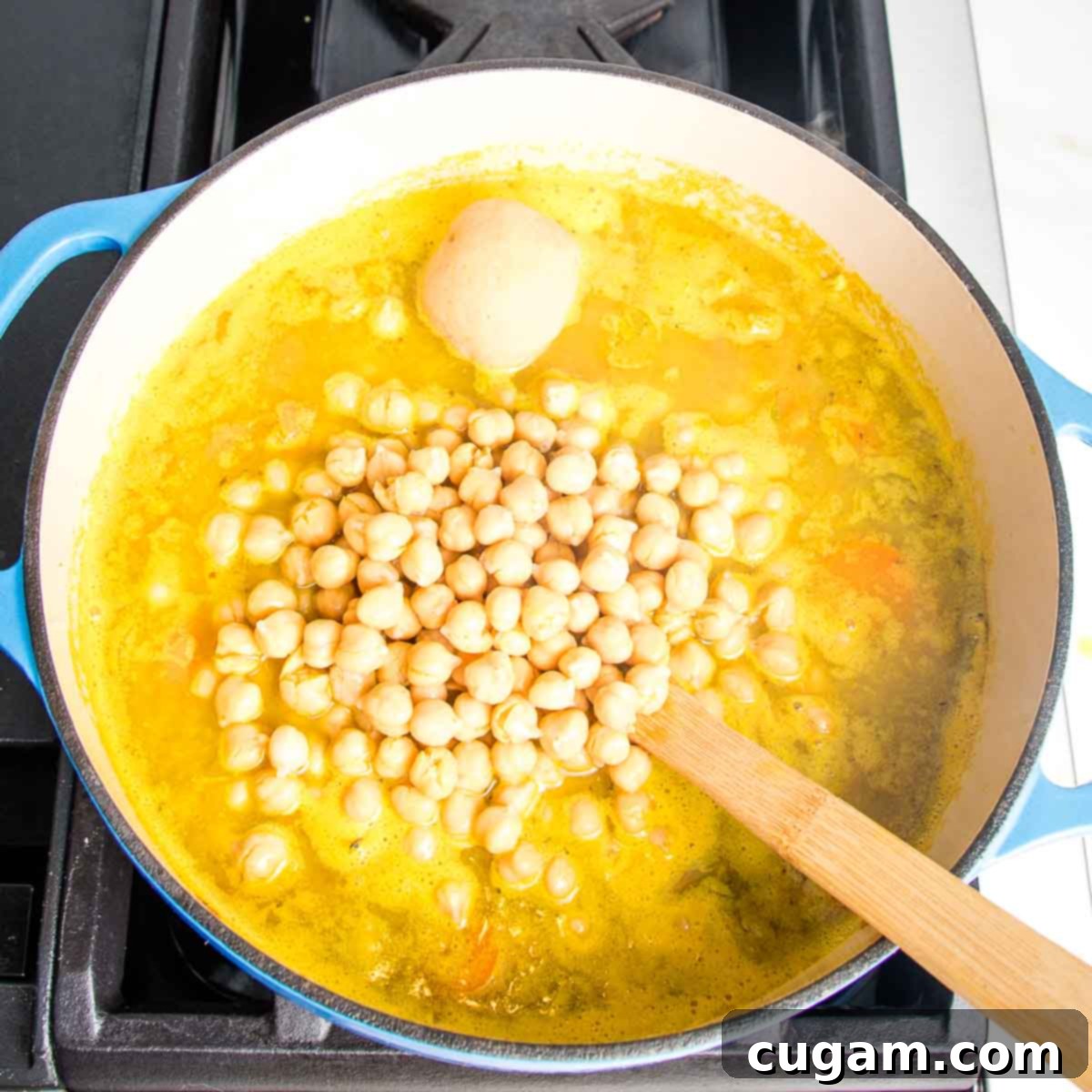
While the rice continues to cook, the chickpeas will absorb the wonderful flavors of the miso and spices, deepening their taste. For the final, essential flavor boost, zest both lemons directly into the pot and then squeeze in their fresh juice. Stir everything well to combine.
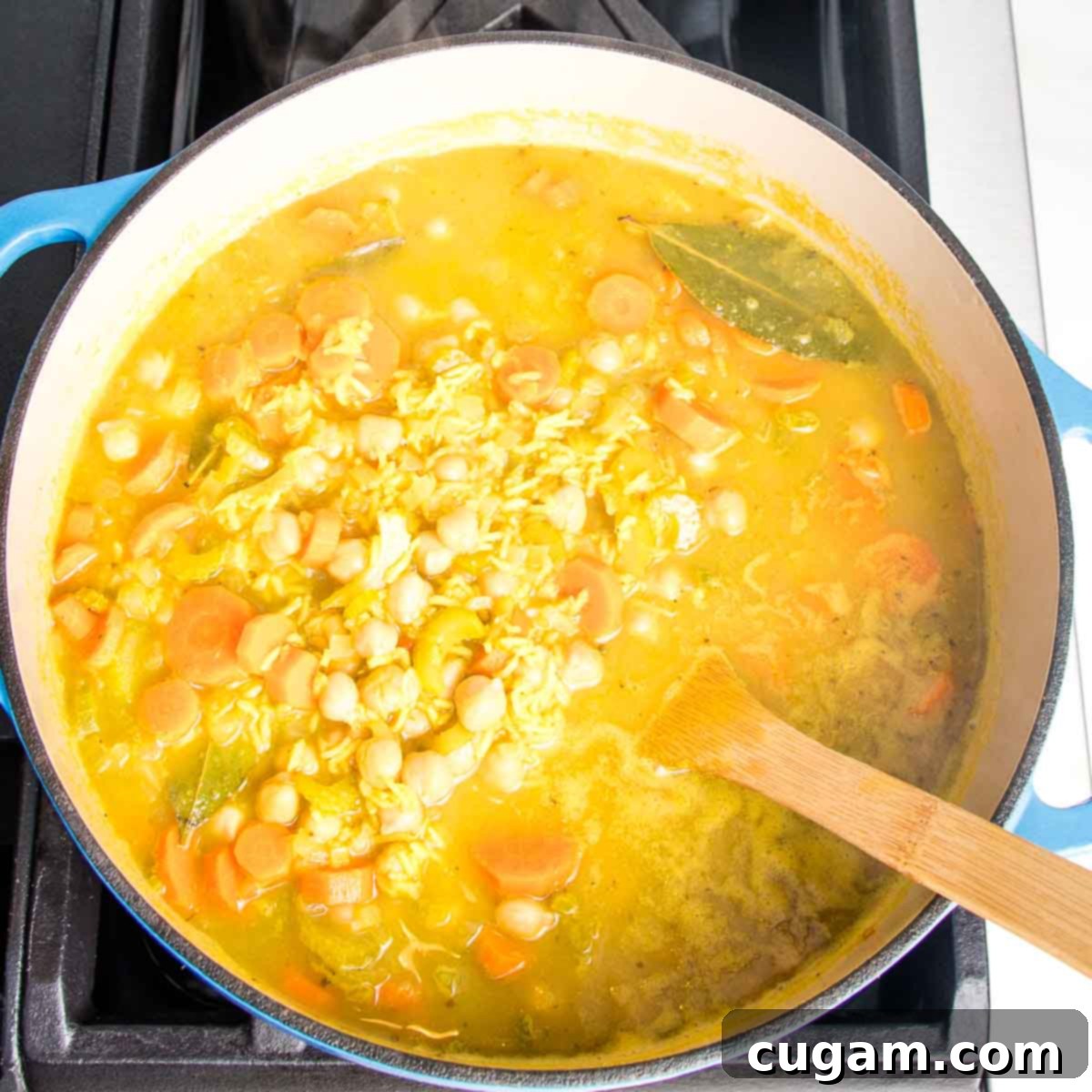
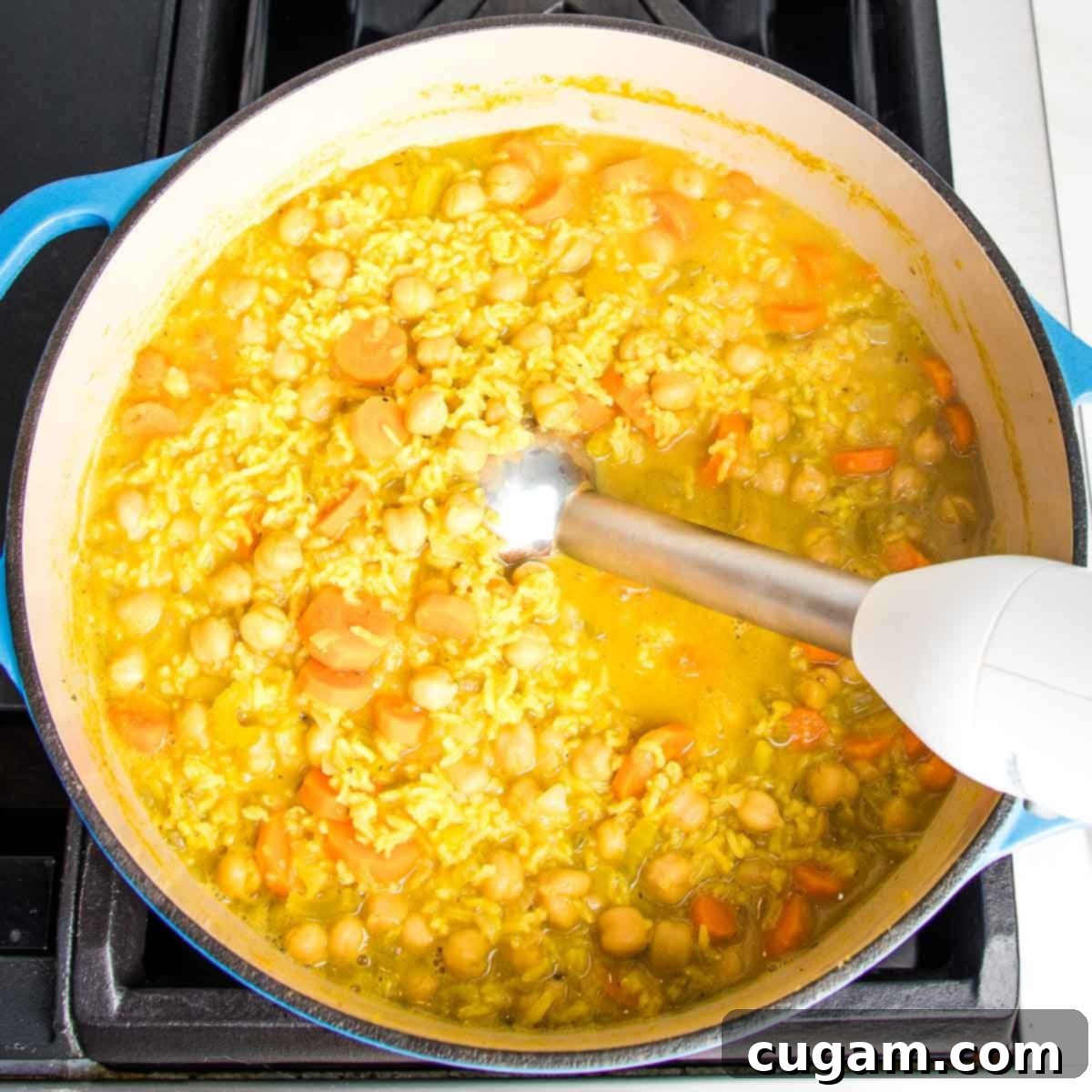
For a beautiful, varied texture, I love to use an immersion blender to partially puree a portion of the soup directly in the pot. This creates a creamy base while still leaving plenty of delightful chunky bits of chickpeas and vegetables – because texture is fun and adds to the satisfaction! If you don’t have an immersion blender, carefully scoop a cup or two of the soup into a regular blender, blend until smooth, and then return it to the pot.
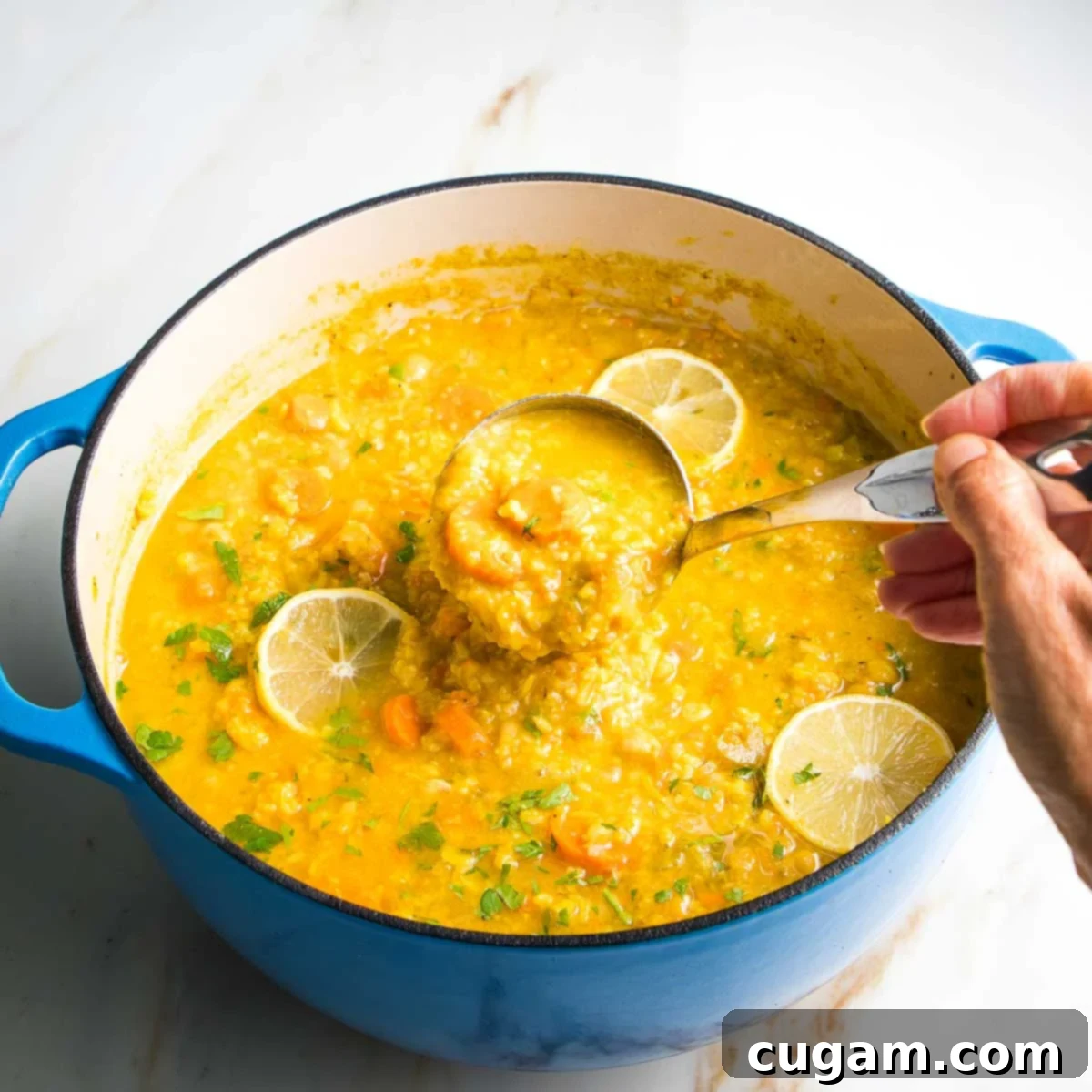
Before serving, taste the soup and adjust seasonings as needed. A final squeeze of lemon juice can brighten the flavors even further. Garnish generously with fresh herbs. I particularly love chopped parsley for its vibrant color and fresh taste, but cilantro, basil, oregano, or fresh thyme would also complement this soup beautifully.
Debra’s Pro Tips for the Best Lemon Chickpea Rice Soup
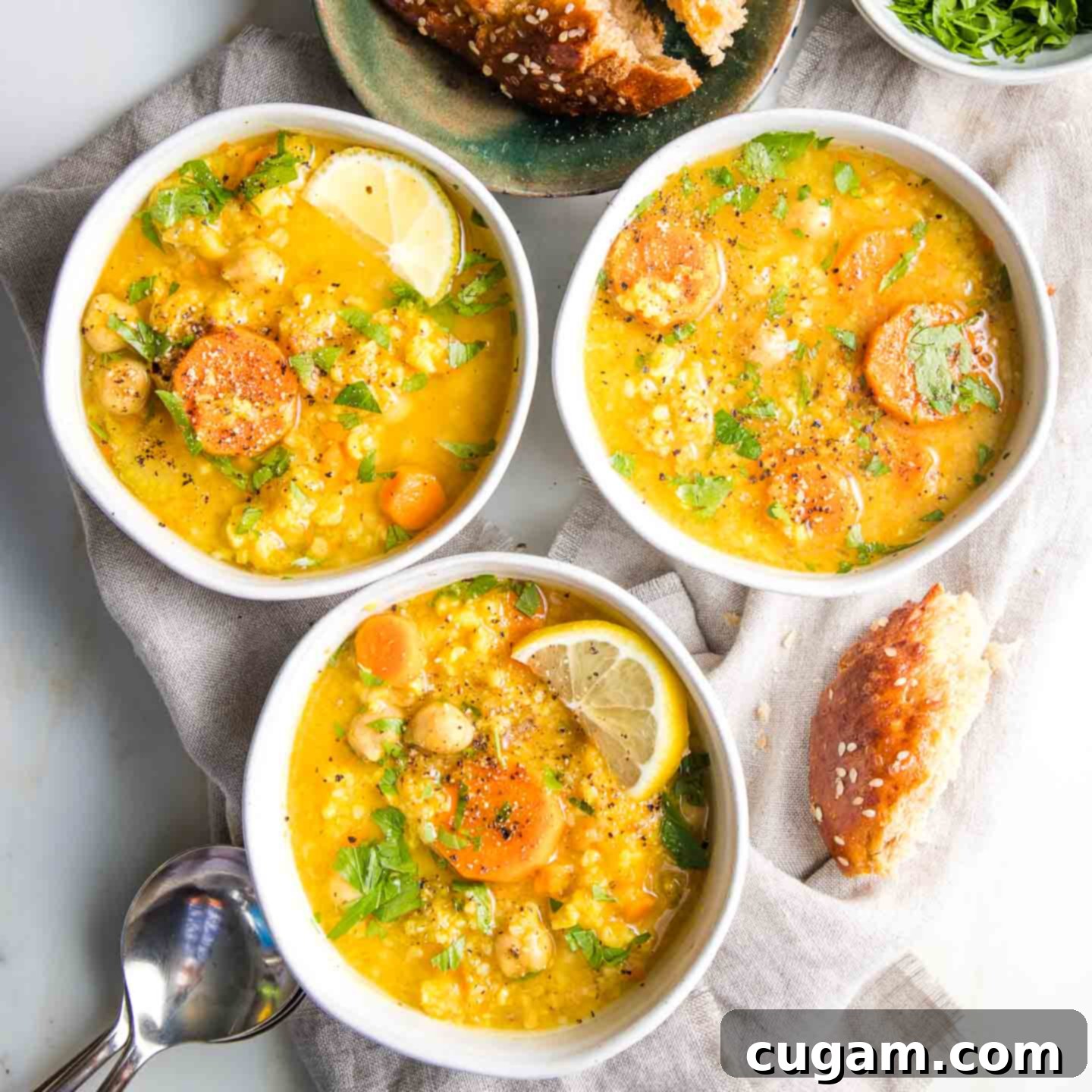
- Seasoning is Key: Once the soup is completely finished cooking, always taste it. Add an additional squeeze of fresh lemon juice before deciding if more salt is truly needed. The lemon’s acidity often enhances the existing saltiness and brightens the overall flavor profile.
- Customize Your Consistency: If you prefer a lighter, more brothy lemon rice soup, feel free to add more vegetable broth to achieve your desired consistency. You can also skip the partial pureeing step entirely to keep all the ingredients chunky.
- The Perfect Texture Balance: For a varied and truly fabulous textural experience, my personal preference is to puree about half the soup with an immersion blender. This creates a creamy, rich base while leaving plenty of delightful chunks of chickpeas and vegetables to enjoy.
Serving Suggestions
This versatile Lemon Chickpea Rice Soup is hearty enough to be a complete meal on its own, but it also pairs wonderfully with a few simple accompaniments. Serve it alongside a slice of warm, crusty bread or a fresh green salad with a light vinaigrette. A sprinkle of red pepper flakes can add a touch of heat if you enjoy a little kick. For an extra layer of freshness, a dollop of vegan yogurt or a drizzle of good quality olive oil can be a delightful addition.
Storage and Freezing Instructions
One of the many benefits of this chickpea soup is how well it stores. Leftovers are often even more flavorful as the ingredients have more time to meld together.
- Refrigerator: Allow the soup to cool completely, then transfer it to an airtight container. It will keep beautifully in the refrigerator for up to 4-5 days. Note that the rice will continue to absorb liquid and the soup will thicken, so you may need to add a splash of water or broth when reheating to reach your desired consistency.
- Freezer: This soup freezes exceptionally well! Once completely cooled, ladle the soup into freezer-safe containers or heavy-duty freezer bags, leaving some headspace for expansion. It can be frozen for up to 3 months. To reheat, thaw overnight in the refrigerator or gently reheat from frozen on the stovetop over low heat, adding extra broth or water as needed until warmed through.
More Delightful Chickpea Recipes You’ll Love
- Healthy Baked Falafel Recipe
- Tuscan Kale Chopped Salad
- Chocolate Chunk Skillet Cookie (vegan & gluten-free)
- Vegetable Pesto Pasta Salad without Mayo!
Did you know commenting and rating recipes is one of the best ways to support your favorite food bloggers? If you made this delicious Lemon Chickpea Rice Soup, please consider leaving a five-star rating below and a comment sharing your experience. Also, we’d love to see your creations! Please share your photos on Instagram by tagging me @dkhealthcoach and using the hashtag #debraklein. Your support means the world!
📖 Recipe

Chickpea Soup with Lemon and Rice
Debra Klein
Rate this Recipe
Pin Recipe
5 minutes
40 minutes
45 minutes
Soup
American
8
Servings
224
kcal
Equipment
-
Hand blender
-
Wooden Spoon Set
-
Microplane
-
Colander
-
Extra Large Bamboo Cutting Board
-
Global 8″ Chef’s Knife
-
Dutch oven
Ingredients
- 1 large yellow onion or two smaller onions: about 1 cup chopped
- 4 large carrots 2 cups sliced
- 3 celery ribs 1 cup sliced
- 6 cloves garlic
- 1 teaspoon dried oregano
- 1 teaspoon ground cumin
- 1 teaspoon ground coriander
- ½ teaspoon ground turmeric
- ½ teaspoon coarse sea salt*
- ⅛ teaspoon freshly ground pepper
- ¾ cup basmati rice*
- 8 cups veggie broth
- 3 cups chickpeas 2 15-oz cans, rinsed and drained
- ¼ cup light miso*
- 3 bay leaves
- 2 lemons zested and juiced
- ¼ cup fresh parsley*
Instructions
-
Prepare ingredients: roughly chop the onion(s), thinly slice the celery, and slice carrots into small circles. Peel garlic cloves and measure spices. Rinse and drain chickpeas; rinse rice until water runs clear.
-
Heat a large soup pot over medium heat. Sauté onion, celery, and carrot in 2 Tablespoons water or broth, adding more as needed (1 Tablespoon at a time) so veggies don’t stick to the bottom of the pan. Cook, stirring occasionally for 5 minutes, until veggies are starting to soften and are lightly browned.
-
Use a microplane grater (or garlic press) to grate garlic into the pot along with oregano, cumin, coriander, turmeric, salt, and pepper. Cook, stirring for 2 minutes, adding additional water/broth if the bottom of the pot is too dry.
-
Add rinsed rice and stir to coat with spices. Then add veggie broth. Bring to a simmer and cook, uncovered for 20 minutes. Stir in beans and miso until miso has dissolved. Continue to simmer for 10-15 minutes, until rice is chewy but not mushy. Remove bay leaves, zest and juice the lemon into the pot and stir well.
-
Puree a cup or two of the soup in a blender and return to the pot. OR, blend directly in the pot using an immersion blender. If the soup is too thick, add more water/broth until desired consistency is achieved*. Taste for seasoning, adding more salt and pepper as needed.
Notes
RICE: Use what you have/what you know you like. In addition to basmati, jasmine is a great option. White rice will be easier to digest and cook in less time than brown. If you use wild rice, add another 10 minutes to cooking time and wait for it to “pop” to know it’s done, but keep it chewy, no matter which variety you choose.
MISO: I used mellow light miso. I also have used chickpea miso, which is a great choice for those allergic to/cutting back on soy.
GARNISH: I used ¼ cup chopped parsley. Fresh cilantro, basil, oregano, and thyme are also good choices.
SOUP CONSISTENCY: Add more water/stock for a more broth-y soup. Also, this will thicken as it cools, so you may need to add more water than you originally thought.
Nutrition
Serving:
1
g
Calories:
224
kcal
Carbohydrates:
37
g
Protein:
11
g
Fat:
3
g
Polyunsaturated Fat:
2
g
Cholesterol:
1
mg
Sodium:
472
mg
Fiber:
11
g
Sugar:
10
g
Note
The nutrition calculations were done using online tools. To obtain the most accurate representation of the nutritional information in any given recipe, you should calculate the nutritional information with the actual ingredients you used. You are ultimately responsible for ensuring that any nutritional information is accurate, complete and useful.
Did you make this recipe?
Please leave a review below, then snap a picture and tag me @dkhealthcoach or use hashtag #dkhealtcoach on Instagram so I can see it!!
